05-830, User Interface Software, Spring,
2000
Lecture 13, April 10, 2000
Copyright © 2000 - Brad Myers
Previous Lecture
. . . Next
Lecture
Amulet's Input Model:
Interactors and
Command Objects
code and pictures
Overview
-
Try to provide more support so input handling isn't so difficult
-
Make easy things simple and complex things possible
-
Based on the "Model-View-Controller" architecture from Smalltalk
-
True separation of graphics (view) and input handling (controller)
-
Also uses idea from Foley&Wallace of identifying types of input
handlers:
-
move
-
grow
-
rotate
-
text edit
-
gesture
-
select (pick)
-
Innovations:
-
Identifying primitive "Interactor" objects and correct parameterizations
so most direct manipulation UIs can be constructed by re-using built-in objects.
-
Only a few kinds of behaviors, and standard parameters
-
Real separation between input and output handling
-
Handles all input
-
insides of widgets
-
and for application programs
-
+ First successful separation of View from Controller in Smalltalk MVC
-
+ Integration of gestures with conventional interaction.
-
+ Easier to code because substantial re-use
-
+ Built-in support for multi-window dragging
-
General idea: attach interactor objects to a set of graphical objects to
handle their input.
-
Graphical objects don't handle input
-
No "event methods" in objects
-
Instead, define invisible "Interactor" objects and attach them to graphics
-
Interactors can operate on multiple objects
-
Strategy: pick the right type of Interactor, attach to the objects to be
moved, fill in necessary slots of interactor
-
Widgets use interactors internally
-
Can have multiple interactors on an object (e.g., different mouse buttons)
-
Interactors directly set slots of objects,
-
constraints can be used to map those slots into behaviors:
-
Details of input events and event processing is hidden
-
Interactor directly sets slots of objects using a standard protocol
-
Used first in Garnet, refined in Amulet.
Types of Interactors
-
Am_Choice_Interactor : select one or more of a set of objects
-
Am_One_Shot_Interactor - single action, like Choice
-
Am_Move_Grow_Interactor : move or grow objects with the mouse
-
Am_New_Points_Interactor: to create new objects by entering points while
getting feedback "rubber band" objects
-
Am_Text_Edit_Interactor : mouse and keyboard edit of text
-
Am_Gesture_Interactor: interpret freehand gestures
Parameters for all Interactors
-
set of objects to operate on:
-
To be active, Interactor must be attached to an object which is (recursively)
attached to the screen
-
Equivalent to visibility of graphical objects
-
Unlike graphical objects which can only be added as parts of windows or groups,
interactors can be added as parts of any
object:
rect.Add_Part(my_inter);
-
Default: operates on the object attached to
-
But also common to operate on any member of a group.
-
Controlled by the Am_Start_Where_Test slot, which should contain a method.
SP_Ship_Mover =
Am_Move_Grow_Interactor.Create("SP_Ship_Mover")
.Set (Am_START_WHEN, "LEFT_DOWN")
.Set (Am_START_WHERE_TEST, Am_Inter_In_Part);
ship_group.Add_Part(SP_Ship_Mover);
-
Multiple groups
-
interactor can span multiple windows
-
start, stop and abort events
-
- single key, mousebutton, "any" mousebutton, modifiers, (shift, meta...),
double click, click vs. drag, etc.
-
active?
-
priority levels
Parameters for specific types of Interactors
-
For buttons (Choice Interactors)
-
how many objects to select: set, toggle, list-toggle
-
For move-grow:
-
interim feedback object (while the mouse moves)
-
if missing then object itself is modified
Am_Object feedback_circle = moving_circle.Create()
.Set (Am_LINE_STYLE, Am_Dashed_Line)
.Set (Am_VISIBLE, false);
my_win.Add_Part (feedback_circle);
// The definition of the interactor
Am_Object objs_grower = Am_Move_Grow_Interactor.Create ()
.Set (Am_START_WHERE_TEST, Am_Inter_In_Part)
.Set (Am_GROWING, true) // grow instead of move
.Set (Am_FEEDBACK_OBJECT, feedback_circle);
objs_group.Add_Part (objs_grower);
-
gridding
-
move or grow
-
where-attach
-
center, n, ne, nw, w ... , where-hit
-
flip if change sides
-
minimum size
-
For New_Point:
-
interim feedback object (while the mouse moves)
-
gridding
-
minimum size
-
abort if too small
-
Text-interactor:
-
editing translation table (to map keystrokes and mouse into editing functions)
-
Gesture-interactor:
-
gesture recognizer table
-
If missing, can use this to get freehand drawings
Simple Example
-
To make an object movable with the mouse:
Am_Object rect = Am_Rectangle.Create()
.Set(Am_LEFT, 40)
.Set(Am_TOP, 50)
.Set(Am_FILL_STYLE, Am_Red)
.Add_Part(Am_Move_Grow_Interactor.Create());
Standard Behavior

Operation
-
Interactors do 3 things
-
modify objects directly
-
set Am_VALUE slot of their command
-
call the command's Am_DO_METHOD

-
Can just have a constraint from an object or widget to the Am_VALUE of the
widget
-
Method to override for application-specific operations
-
Fill in the UNDO_METHOD to support undo
Choice Interactor
-
Three ways to get the result:
-
Access the Am_INTERIM_SELECTED and Am_SELECTED slot of the object itself
-
By default, sets the Am_INTERIM_SELECTED and Am_SELECTED slots of the affected
objects
-
Constraints that depend on these slots
-
Access the Am_VALUE slot of the interactor
-
Write a Am_DO_METHOD for the command object, and access the command object's
Am_VALUE slot
Am_Define_Style_Formula (line_from_selected) {
if ((bool)self.Get(Am_INTERIM_SELECTED))
return Am_Red;
else if ((bool)self.Get(Am_SELECTED))
return Am_Black;
else return Am_Blue;
}
Am_Object my_prototype = Am_Line.Create()
.Set(Am_LINE_STYLE, line_from_selected);
my_group = Am_Group.Create()
.Add_Part(Am_Choice_Interactor.Create()
.Set(Am_START_WHERE_TEST, Am_Inter_In_Part);
-
Now add instances of my_prototype to my_group
-
Also collects a list of the selected objects in the Am_VALUE slot of the
command object in the interactor
Values
-
Value of Command in Choice Interactor set to object selected
-
Value of Command in button-type widgets set to Label of command, or Am_ID
field of the command
-
Remember, label can be a string or a graphical object
Debugging: Tracing
-
Can turn on tracing and get print out of which Interactors run and what they
do
-
Options: trace all, trace only setting of slots, trace a particular interactor,
short trace (only which interactors run), etc.
-
Inspector just toggles inspecting all or none
-
Printout to console window
<><><><><> LEFT_DOWN x=180 y=289 time=3114329169
Enter GO for <grow_inter_in_handle_185>, state=0...
Checking start event against wanted = LEFT_DOWN * SUCCESS
Checking start where.. ~~SUCCESS=<Am_Rectangle_650>
Move_Grow starting over <Am_Rectangle_650> translated coordinates 169,268
Calculated attach point for non-line is Am_ATTACH_S
++Object <grow_inter_in_handle_185> setting Am_VISIBLE of <Sel_Rect_Feedback_197> to true
++Object <grow_inter_in_handle_185> setting obj=<Sel_Rect_Feedback_197> setting obj=<Sel_Rect_Feedback_197> LEFT=90 TOP=142 WIDTH=182 HEIGHT=148
<><><><><> LEFT_UP x=179 y=326 time=3114329838 drawonable=Amulet Test Selection Widget(0x4015b848)
Enter GO for <grow_inter_in_handle_185>, state=1...
Checking abort event against wanted = CONTROL_g * FAILED
Checking running where.. ~~SUCCESS=<window>
Checking stop event against wanted = ANY_MOUSE_UP * SUCCESS
Move_Grow stopping over <Am_Rectangle_650>
++Object <grow_inter_in_handle_185> setting Am_VISIBLE of <Sel_Rect_Feedback_197> to false
++Object <grow_inter_in_handle_185> setting obj=<Am_Rectangle_650> setting obj=<Am_Rectangle_650> LEFT=79 TOP=121 WIDTH=182 HEIGHT=185
Advanced Feature: Priorities
-
If two interactors want to run, priorities used to determine which
-
Am_PRIORITY slot contains a number. Default = 1
-
When running, 100 added to it
-
Inspector interactors use 300.0
-
If multiple with same priority, runs the one attached closer to the leaf
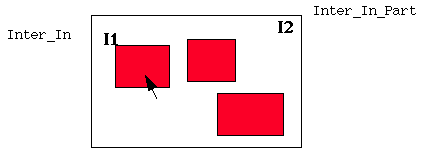
Advanced Feature: Slots of Interactor
-
In addition to value set into Command, a number of slots are set into the
Interactor itself, which might be useful.
-
Can get the interactor as the Owner of the command passed to the DO_METHOD
-
Am_START_OBJECT, Am_START_CHAR, Am_FIRST_X, Am_FIRST_Y, Am_WINDOW,
Am_CURRENT_OBJECT
Doing something with results: Command Objects
-
Each Interactor and Widget has a Command object as a part in the Am_COMMAND
slot
-
Instead of executing a callback function, interactors and widgets create
a "Command Object" and execute its "Do" method
-
Slots of command object:
-
DO_METHOD
-
UNDO_METHOD
-
REDO_METHOD (undo the undo)
-
SELECTIVE_UNDO
-
SELECTIVE_REPEAT and SELECTIVE_REPEAT_On_NEW
-
HELP: for "balloon" or status line
-
LONG_HELP
-
ACTIVE (enabled) -- usually contains a constraint
-
VALUE, OLD_VALUE
-
etc.
-
Like Command Objects in MacApp, but hierarchical
-
Customize by overriding default methods
Handling Undo
-
Add an undo-handler to the window
-
Each command will be registered with the undo handler
-
Built-in types of undo handlers
-
One undo then redo, like Mac
-
Infinite undo, one redo
-
Selective undo mechanism
-
Each DO method saves necessary information for undo in command object
-
Implementing selective undo not much harder than regular undo:
-
Allocates a new command object and adds to top to history list
-
Semantics is based on what the user would want
-
Undo the operation in a new context means to set the object back to its previous
value
-
Enabled if object is still available
-
Undo of create is delete
-
Redo the operation means to set the value of the object again; create a new
object
-
Also, redo on new object
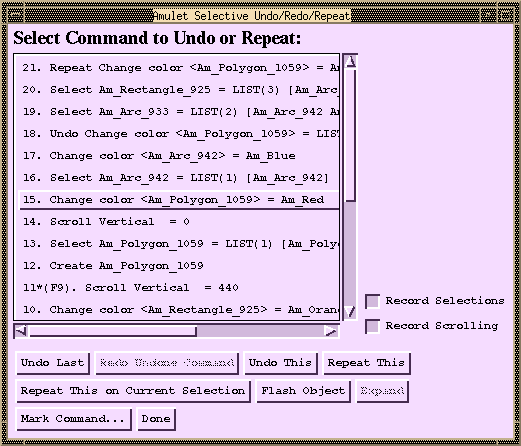
Commands in Widgets
-
Various kinds of button panels:
-
Take list of items in the Am_ITEMS slot as an Am_Value_List
-
Contents of list can be strings, graphical objects, or instances of Am_Command
-
If commands, then the Am_LABEL field is used, and the DO_METHOD of that command
is called
-
If not commands, then DO_METHOD of the top-level widget is called
-
For menu_bar, Am_ITEMS slot of each top-level command contains Am_Value_List
of the sub-commands
Innovations
-
+ Better reuse
-
Many commands are in the library and are usually used without change
-
Cut, Copy, Paste, Create-Object, Delete-object, To-Top, etc.
-
Usually can be used without change
-
Easier to customize when necessary
-
+ Better modularization
-
Hierarchical means each level only has to deal with its own actions
-
+ New form of selective undo, repeat
-
Includes undo/repeat of selections and scrolling
-
+ Single place for enabling, help, label, etc.
-
Can be computed by constraints
-
+ Makes scripting easier
-
End-User programming by demonstration
-
Parameterization possible without help from application
-
+ May help with CSCW
-
Executing the command on multiple machines
Scripting
-
New feature (CHI'98)
-
Select set of commands and specify that in a program
-
Can parameterize actions
-
Moving selection handles
-
-
Forwards, backwards, left, right, up, down, in, out
-
Search for object of a particular type or value
-
Little or no change to application if it supports Selective Repeat
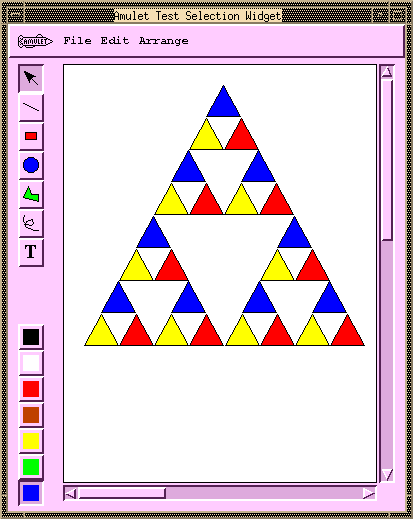
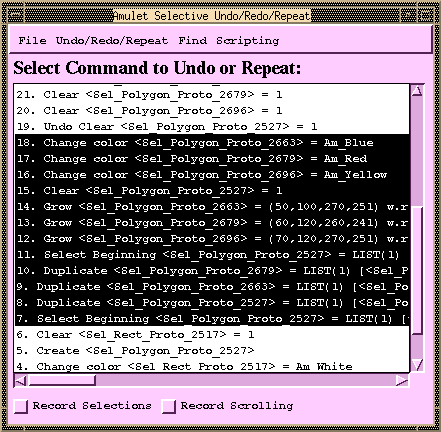
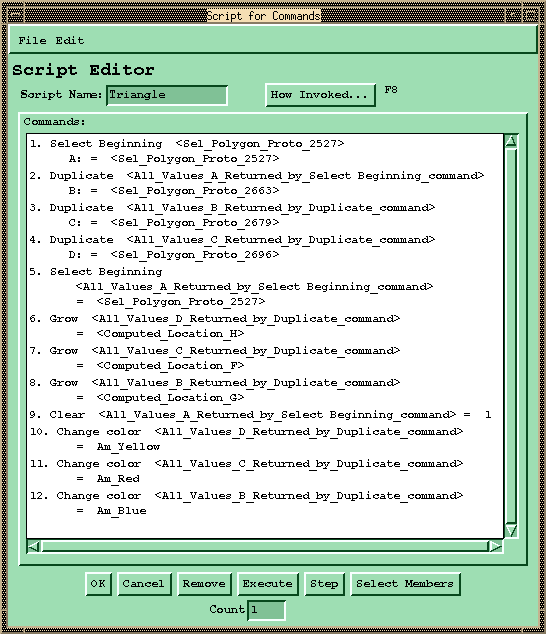
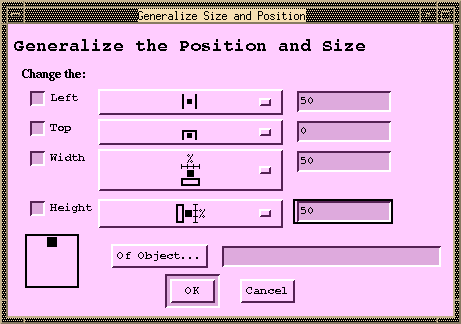

Back to 05-830 main page









